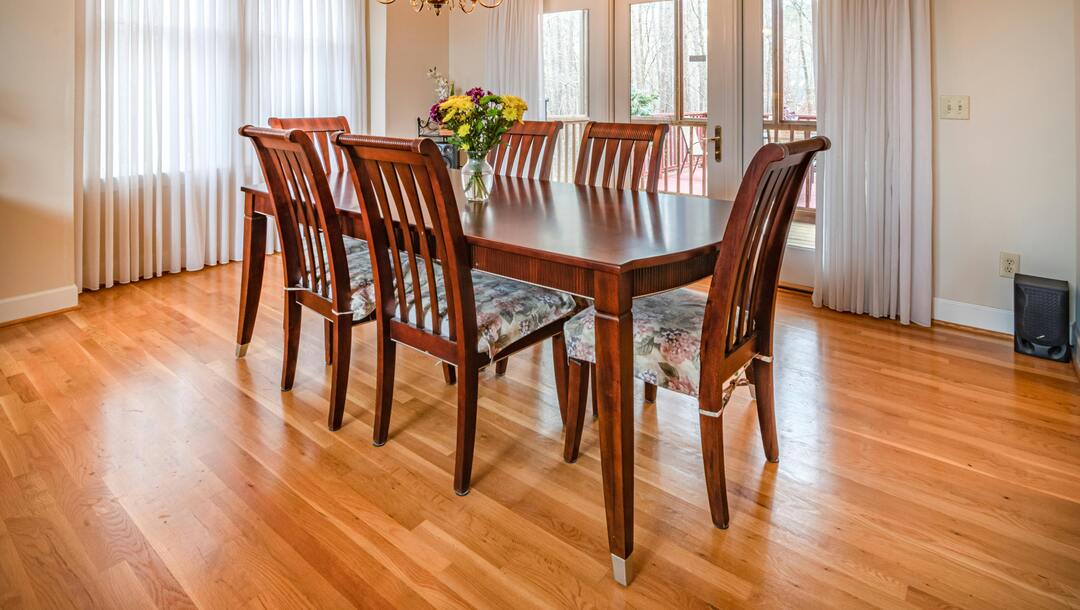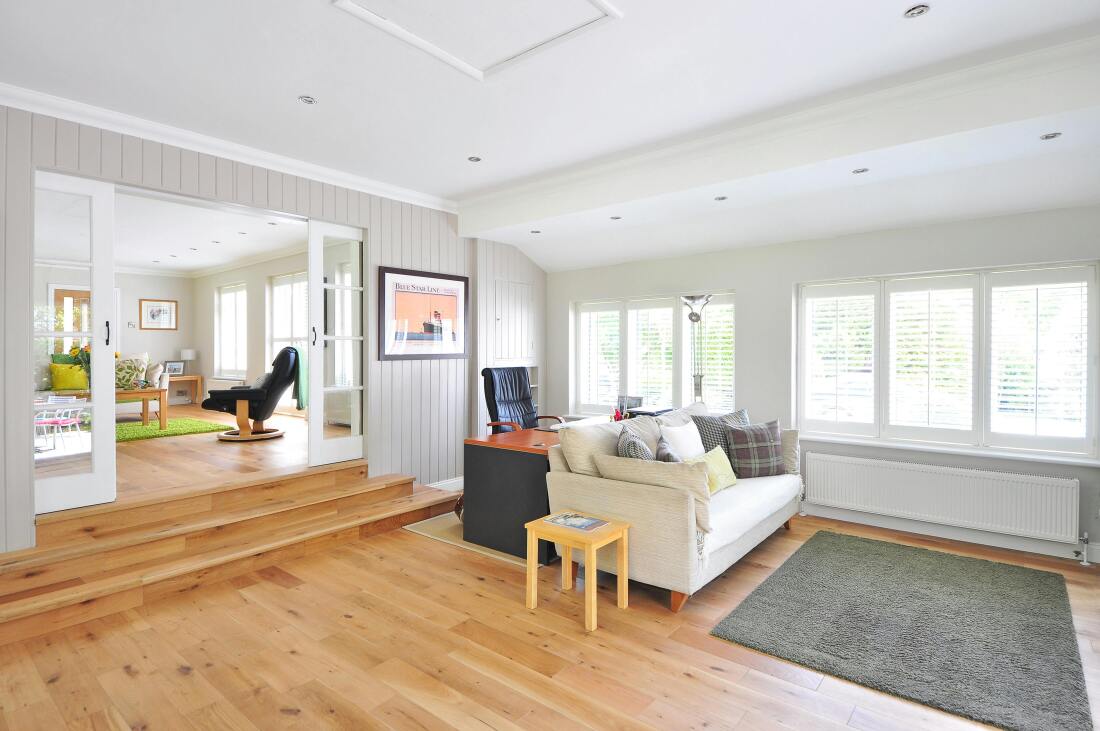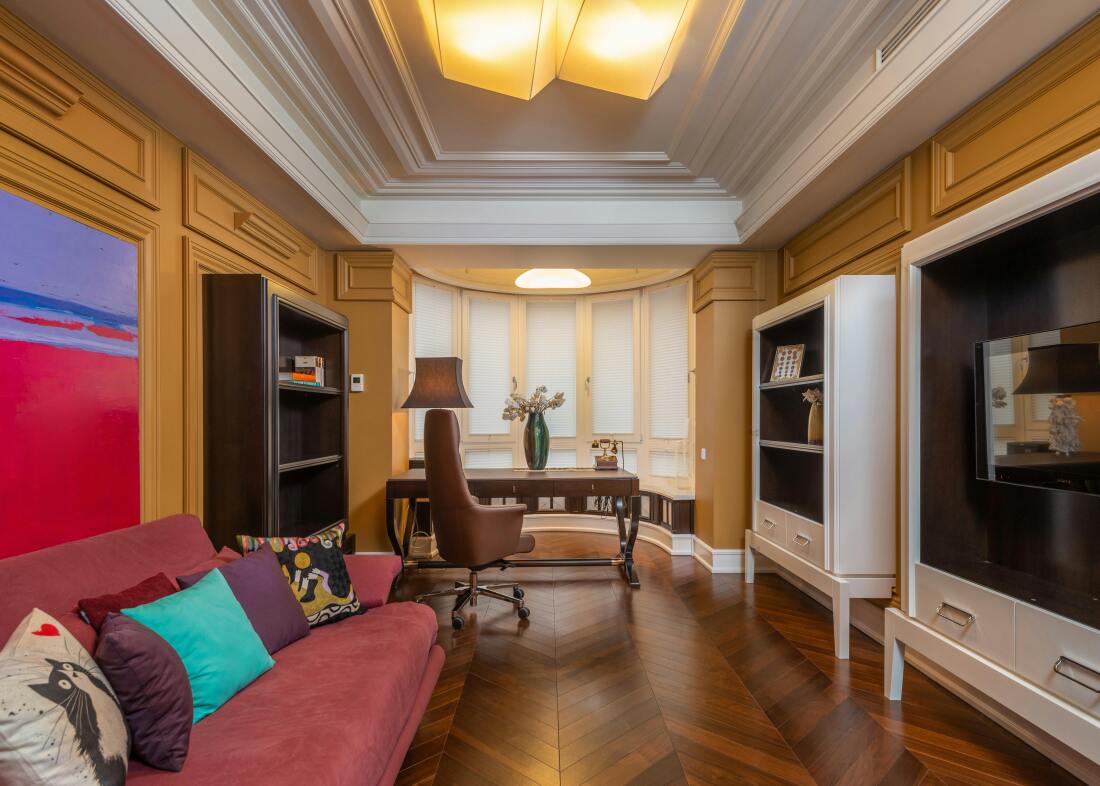
Benefits of Hardwood Flooring
February 23, 2024Imagine stepping onto floors that whisper stories of resilience and warmth. Hardwood flooring, with its timeless appeal and unmatched durability, adds a touch of sophistication and elegance to any space. But beyond its beauty, hardwood offers a wealth of benefits that make it a smart investment for your home.
Aesthetic Appeal
Hardwood floors offer a wide variety of wood species, colours, and finishes, but oak flooring stands out for its natural beauty and versatility. Oak wood comes in a range of colours from light to dark, including white oak and red oak, and it can be finished in matte, glossy, or hand-scraped styles, providing endless design options for any space.
Oak wood flooring adds warmth and elegance to any room, complementing both traditional and modern interior design styles. Its versatility allows for customization to suit different aesthetics, from rustic farmhouse to sleek and contemporary.
Solid hardwood flooring, especially oak, can enhance the overall look of a home by making it appear wider and bigger, which is especially beneficial in small spaces. The natural grain and texture of oak wood leave a lasting impression, adding character and charm to any room.
In conclusion, oak flooring is a timeless choice for adding aesthetic appeal and sophistication to any space, with its wide range of colours, finishes, and versatility to suit various interior design styles.
Timeless and elegant look
Hardwood floors exude a timeless and elegant appeal with their natural beauty and versatile design. The warm, rich, luxurious feel and look of wood floors add a touch of sophistication and charm to any space. Oak flooring, in particular, is renowned for its natural wood patterning and grain, giving it a striking and unique aesthetic appeal.
One of the key attributes of hardwood floors is their ability to adapt to various interior design styles, seamlessly complementing traditional, modern, or eclectic décor. Their durability and longevity make them a practical and long-lasting choice for any home. When properly cared for, wood floors can last for decades and can be easily revived to their original state through sanding and sealing, ensuring that their timeless style endures for years to come.
Whether in a classic or contemporary setting, hardwood floors never go out of style, making them a timeless and elegant choice for any home. Their natural beauty, versatility, and durability make them a popular choice for homeowners seeking a sophisticated and long-lasting flooring option.
Enhances the overall appearance of a room
The overall appearance of a room can greatly impact the atmosphere and perception of the space. The right enhancements can make a room feel more inviting, lively, and put-together. Whether through the use of color, texture, or layout, small changes can make a big difference in the overall aesthetic of a room. In this section, we will explore different ways to enhance the overall appearance of a room, from selecting the right furniture and decor to utilizing lighting and spatial organization techniques.
Durability
Hardwood flooring is known for its durability, which is attributed to several factors. Firstly, hardwood flooring is extremely stable, meaning it is less prone to expansion and contraction due to changes in temperature and humidity. This stability helps to prevent warping, cupping, or gapping in the flooring. Additionally, hardwood flooring is highly impact-resistant, able to withstand heavy foot traffic and resist damage from falling objects or furniture.
Oak wood, in particular, is renowned for its exceptional durability. This is due to its high density, which makes it less susceptible to dents, scratches, and wear compared to other hardwoods. Oak wood is also able to withstand hard use and heavy foot traffic, making it an excellent choice for high-traffic areas in homes.
For those looking for top-quality wood options for longevity and cost-effectiveness, oak wood is a popular choice. Other hardwoods, such as maple, cherry, hickory, and walnut, are also known for their durability and longevity, making them excellent options for wood flooring. When properly maintained, these hardwoods can last for generations, making them a cost-effective investment in the long run.
Resistant to wear and tear
To maintain the resistance to wear and tear of both solid oak and engineered hardwood floors, it is important to implement a regular cleaning routine. Use a soft broom or a vacuum with a soft brush attachment to remove any dirt, debris, or small particles that may cause scratches over time. Additionally, consider using protective pads under the legs of furniture to prevent any potential damage from regular use.
Applying a protective finish to the hardwood floors can help minimize scratches and stains, thus maintaining their resistance to wear and tear. It's important to address any spills or stains immediately by gently blotting the affected area with a clean, damp cloth to prevent any lasting damage.
By consistently following these maintenance practices, you can help preserve the durability and appearance of your solid oak and engineered hardwood floors, providing long-lasting resistance to wear and tear.
Long-lasting option for high traffic areas
When it comes to choosing flooring for high traffic areas, durability is essential. A long-lasting option for these spaces is crucial to ensuring that the flooring holds up to constant use without showing signs of wear and tear. In this section, we will explore some of the best long-lasting flooring options for high-traffic areas, considering factors such as durability, maintenance, and overall performance. Whether it's for a commercial space, an office building, or a busy household, selecting the right flooring material can make a significant difference in the longevity and appearance of the space. Let's take a look at the top long-lasting options for high-traffic areas and how they can withstand the demands of constant use.
Easy Maintenance
Maintaining hardwood floors can be easy with a few best practices. Regular dusting with a dry cloth or microfiber mop helps prevent dirt and debris from scratching the surface. Immediate cleanup of spills is essential to prevent staining and warping of the wood. When it comes to restoring shine, using a specialist floor cleaner specifically designed for hardwood is recommended.
For quick repairs, using epoxy resin or wood glue can effectively fix any scratches, dents, or cracks in the flooring. This helps maintain the integrity and aesthetics of the hardwood. It's also important to avoid excessive water or all-purpose cleaning solutions, as these can cause damage to the wood over time. By following these easy maintenance practices, hardwood floors can stay looking beautiful for years to come.

Simple cleaning routine
for hardwood floors. Start by using a soft brush attachment on your vacuum or a soft broom to gently remove any dust, dirt, and debris from the hardwood surface. This step is important to prevent scratching the floor during the cleaning process.
Next, prepare a cleaning solution by mixing a pH-neutral cleanser with water. Avoid using harsh chemicals or acidic cleaners, as they can damage the hardwood. Mop the floors with the cleaning solution, making sure to wring out the mop well to prevent excessive water from seeping into the wood.
After mopping, consider polishing the hardwood floors to restore their natural sheen. You can create a homemade solution by mixing equal parts olive oil and white vinegar. Gently apply the solution to the floors using a soft cloth, and then buff in a circular motion to achieve a polished finish.
By following this simple cleaning routine regularly, you can keep your hardwood floors looking clean and well-maintained without causing any damage. Remember to use a soft brush attachment for vacuuming or sweeping, opt for a pH-neutral cleanser for mopping, and finish with a homemade solution for polishing.
Does not trap dust or allergens like carpet
When it comes to choosing flooring for your home, it's important to consider how each option can impact the air quality and allergen levels in your space. One popular flooring choice, carpet, has long been known for trapping dust and allergens, causing problems for individuals with allergies or respiratory issues. In contrast, there are flooring options available that do not trap dust or allergens, like carpet, providing a cleaner and healthier environment for you and your family. In the sections below, we will explore these alternatives and discuss how they can contribute to better air quality and overall well-being in your home.
Allergy-Friendly
Wood flooring is a great option for allergy sufferers due to its ability to prevent the trapping of dust, dirt, and pollen. Unlike carpeting, hardwood floors don't harbor allergens, making it easier to keep the home free of potential triggers for allergy symptoms. Regular vacuuming or sweeping can easily remove allergens from wood flooring, promoting a healthier indoor environment for those with allergies.
In addition to being allergy-friendly, hardwood flooring is also a sustainable and eco-friendly choice. Most wood flooring is sourced from sustainably managed forests, ensuring that the production process doesn't contribute to deforestation or habitat destruction. Furthermore, at the end of its useful life, wood flooring can be recycled or repurposed, minimizing its impact on the environment.
Overall, hardwood flooring offers a healthier and more sustainable option for those with allergies and environmental concerns. Its ability to prevent allergen buildup and its eco-friendly properties make it an ideal choice for creating a clean and sustainable living space. For allergy sufferers looking for a low-allergen flooring option, wood flooring is a great choice for promoting better indoor air quality and reducing allergy symptoms.
Ideal for allergy sufferers
Hardwood floors are an ideal choice for allergy sufferers due to their ability to prevent the trapping of dust, dirt, and pollen. Unlike carpeting, which can harbor allergens, hardwood floors allow for easy cleaning and removal of these irritants, creating a healthier indoor environment for individuals with allergies.
In addition to their allergy-friendly properties, hardwood floors are also compatible with radiant heating systems, promoting energy efficiency and providing added comfort. The ability of hardwood floors to conduct and radiate heat makes them an excellent choice for use with radiant heating, ensuring that the heat is evenly distributed throughout the room. This not only saves energy but also creates a more comfortable and consistent indoor temperature.
Overall, hardwood floors are a top choice for allergy sufferers due to their dust prevention abilities and compatibility with radiant heating systems, making them a smart and beneficial flooring option for those looking to improve indoor air quality and energy efficiency.
Does not harbor dust mites or pet dander
When it comes to creating a hypoallergenic environment, it's important to consider the surfaces and materials in your home that could harbor dust mites and pet dander. These allergens can be a trigger for those with sensitivities or allergies, so finding products and materials that do not harbor them is crucial. From bedding to flooring, choosing items that are resistant to these allergens can have a significant impact on the overall air quality and comfort of your home.
Indoor Air Quality
Hardwood floors are a key factor in improving indoor air quality as they do not trap allergens, dust, or pet dander like carpeting can. Additionally, hardwood floors do not emit harmful volatile organic compounds (VOCs) like some synthetic flooring materials do. They also do not foster the growth of mould and mildew, unlike carpets, which can be a common source of indoor allergens. For allergy sufferers, hardwood floors can greatly improve air quality by reducing the presence of allergens, ultimately promoting better respiratory health within the living space.
Oak wood flooring, in particular, offers natural water, fungus, and rot-resistant properties. This makes it a great choice for enhancing indoor air quality and hygiene, as it helps to prevent the growth of mould and mildew in areas prone to moisture buildup. Its resistance to these elements means less potential for indoor air pollution, providing a cleaner and healthier living environment.
Overall, hardwood floors contribute to improved indoor air quality by reducing allergens and pollutants, making them an excellent flooring choice for promoting better air quality and the overall health of the living space.

Improves air quality
Hardwood floors are a great option for improving the air quality in your home. Their smooth surface and lack of grout lines, fibers, and embossing make them easy to clean and prevent the trapping of allergens, dust, and pet dander. Unlike carpet and other flooring options, hardwood floors do not harbor these particles, making it easier to maintain a cleaner and healthier living environment.
Furthermore, hardwood floors do not emit harmful volatile organic compounds (VOCs) like some synthetic flooring materials do. VOCs can contribute to poor indoor air quality and pose health risks. Additionally, hardwood floors are not prone to fostering mold and mildew, which can also degrade air quality and trigger allergies or respiratory issues. By choosing hardwood floors, you can promote better air quality in your home and provide a healthier living space for you and your family.
Reduces allergens in the home
Hardwood flooring is a great option for reducing allergens in the home. Unlike carpeting, hardwood floors minimize the accumulation of dust, pet dander, and other allergens as they do not trap these particles in fibers. This makes it easier to clean and maintain, preventing allergens from building up over time.
Additionally, hardwood floors do not harbor mold, mildew, or other common allergens that can grow in carpeting, further reducing the potential for allergens in the home. This is particularly beneficial for those who suffer from allergies or asthma.
By choosing hardwood flooring, you can create a cleaner and healthier living environment for you and your family. Regular sweeping or mopping is usually sufficient to keep hardwood floors clean and free of allergens, making it an efficient and low-maintenance option.
In conclusion, hardwood flooring is an excellent choice for reducing allergens in the home, as it minimizes the accumulation of dust, pet dander, and other allergens, is easy to clean and maintain, and prevents the growth of mold and mildew.
Uncover the Magic of Hardwood: Explore Its Benefits and Find Your Perfect Floor!
Ready to upgrade? Schedule a consultation for your hardwood project.
- Visit our website today!
- Click here and discover your perfect floor today!





